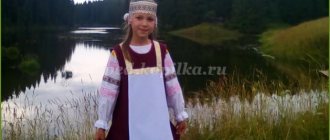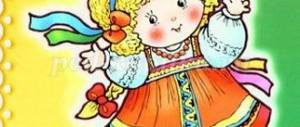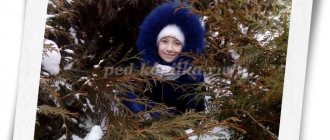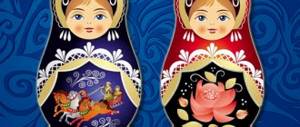Hello, dear friends! Spring! Spring is outside! Spring days! Nature wakes up from its winter sleep. The snow is slowly melting and March is already in a hurry to please us with its first beauty. The first spring flowers, snowdrops, appear right out of the snow.
Of course, we all, even small children, know that they exist. Many have seen them. But what do we know about them? I don't think so much. And therefore, I propose today to learn as much as possible about snowdrops, so that you can later tell your classmates.
What kind of flowers?
So, snowdrops appear on the edges of forests and meadows, along river banks in March-April. They look right out from under the snow. That's why they got their beautiful name.
A strong stem, a pair of shiny green leaves and a white flower with a green edge, similar to a hanging bell, are pleasing to the eye. They grow in large groups, not just one flower at a time.
You can grow these delicate flowers in your garden or vegetable garden. The main thing is to provide them with suitable conditions. They love moist, nutritious soil that is warmed by sunlight.
There are about 18 species of snowdrops in nature, for example:
- snow-white;
- Caucasian;
- Alpine;
- snowdrop Voronova and others.
They are common in Central and Southern Europe, Crimea, the Caucasus and Asia Minor. There are especially many snowdrops in the Caucasus, where you can find representatives of 16 species of this plant.
The harbingers of spring bloom for 3-4 weeks, then the flower petals fall, and in their place appears a round box with three compartments in which black seeds are stored.
Children's presentation "Snowdrops"
Slide 1
Snowdrops Completed by: Kirill Vorobiev, student of class 3 - A of the MBOU "Romanovskaya Secondary School"
Slide 2
Snowdrops appear in the first thawed patches, without waiting for the snow to melt completely. The scientific name of the snowdrop comes from the Greek words “gala (gala)” - milk and “anthos (enchos)” - flower, that is, a milky white flower. In Russian, its name is “breaking out from under the snow.”
Slide 3
VARIETIES OF SNOWDROPERS In nature, there are 12-18 species of snowdrops that grow in meadows, forest edges, wet rocky slopes in the deciduous forests of Central and Southern Europe, Crimea, the Caucasus, and Asia Minor.
Slide 4
The most common snowdrop is snow-white
Slide 5
The second, most famous species is the Elveza snowdrop, native to Turkey and Southeast Europe. Plants of this species are much larger than the white snowdrop. Some varieties of Elvez snowdrop can reach half a meter.
Slide 6
There are also blue Urguik snowdrops
Slide 7
Snowdrops are the messengers of spring! You can say about him - the little sun smiled cheerfully
Slide 8
Snowdrops are the snow earrings of spring!!!
Slide 9
There is a legend about snowdrops. Once upon a time, there lived a brother and sister. Their parents died early, leaving a house on the edge of the forest, and the children were forced to fend for themselves. The brother was a hunter, and the sister was busy with housework. And then one day, when my brother was not at home, my sister decided to collect more snow to wash the floors in the room.
Slide 10
Spring was just coming into its own, and therefore there was still a lot of snow in the forest. The sister took two buckets and went into the forest. She wandered quite far from home. But the girl knew the forest well, and therefore was not afraid of getting lost. But another misfortune awaited her here: the old goblin, riding around his possessions on a lame wolf, saw a girl and realized that such a neat housewife would not bother him. He grabbed her and took her to his den.
Slide 11
But the girl was not at a loss - she pulled a string of river pearl beads left from her mother and began to mark her path with beads. But they fell into the snow without a trace. The girl realized that her brother could not find her and began to cry bitterly. The clear sun took pity on the orphan's grief, melted the snow, and in the place where the pearls fell, the first spring flowers grew - snowdrops. It was through them that the brother found his way to the devil’s den. When the goblin saw that his hiding place had been discovered, he screamed and ran away. And the brother and sister returned to their home and lived happily.
Slide 12
The snowdrop is a small, fragile, but at the same time strong flower that can withstand the harsh conditions of nature.
Slide 13
Flowers decorate our lives!!! It is necessary to remember that you need to take care and protect the beauty around you!!!
Slide 14
Thank you for your attention!
Beauty is under threat
All types of snowdrops are protected by the Red Book of Russia. Therefore, they cannot be picked and sold. But they rip it off and sell it. And if they sell, then they buy.
And you and I can help snowdrops survive. To do this, you just need to stop buying bouquets from merchants. After all, if there is no one to sell flowers to, then there is no need to pick them.
But flowers are threatened not only by pickers and bouquet sellers. Other unfavorable factors are:
- deforestation, which reduces the area where flowers grow;
- trampling and destruction of the forest floor in which the bulbs are hidden;
- environmental problems (soil, water, air pollution).
To date, the Red Book has assigned snowdrops the third category.
This means that they do not disappear yet. But they are found in limited areas and in small numbers. And if measures are not taken, then soon we will no longer be able to admire these magnificent creatures.
Report 3
Snowdrop is the earliest flower. From the Greek galanthus, meaning milky flowers.
Snowdrop is a genus of perennial flowers in the amaryllis family. These are flowers from the order Bulbaceae.
Snowdrops grow in sunny areas, but they also do well in a shady place. They only dislike damp places with stagnant water.
The classic galanthus bud is pure white with small green-yellow splashes on the edge of the petals. The flower resembles the shape of a bell, the resulting structure and location of the petals: three petals in each row. Near the stem of the snowdrop there are 2 leaves 1 cm wide. The leaves are elongated, narrow and flat in shape, with a dark green or gray-green color. The bulb is round, approximately 3 cm in diameter. Each bulb produces 1 flower.
Currently, there are 18 known species of snowdrops - galanthus, and 2 hybrids created by nature. 3 types of them are well known and popular to everyone:
- The snowdrop has more than 50 varieties. This species blooms first among other varieties, but its flowering period is the longest - about 1 month. The height of the snow-white snowdrop is from 7 to 12 cm. The flower buds are fragile, pure white with light yellow large splashes on the petals. Snow-white galanthus exude a delightful aroma.
- Snowdrops are the most famous and popular for us. The flowering of the species begins in the second half of March. The snowdrop is 10 - 15 cm high. The buds differ from the rest in the cut of the petal. The bud size is medium, bell-shaped, pure white with a green mark on the front row of petals.
- Snowdrop Elwes. Distribution areas: forests of Asia Minor. Flowering begins early in March. The flowers are large, from 15 to 25 cm in height. The buds are white, spherical, large.
At first glance, snowdrops are unpretentious for a gardener, but as it turns out, snowdrops are very demanding of the soil. For the bulb to bloom fully, it needs soil well fertilized with peat and humus. The flower should be replanted after the leaves die off, which occurs approximately in the month of July. During this period, the roots of the galanthus bulb had already died off, and a new root system had not yet appeared. The bulb is planted in soil 6-8 cm deep. As a rule, snowdrops bloom well in a well-chosen place for many years and do not need to be replanted. You can also plant snowdrops with seeds, but in this case the fruiting bulb will form only in the third year.
Because of people's love for these delicate flowers, the population is declining sharply every year. Poachers, in order to make money, pluck an unlimited number of snowdrops for sale. To protect this species, the snowdrop was listed in the Red Book.
Snowdrops in creativity
Snowdrops, with their extraordinary fragile beauty, have inspired many people to create.
Poems
Here are some poems.
There are also funny, comic versions)
To some, these white flowers resemble the tears of the Snow Maiden.
And for some, heroes.
Paintings
In the painting by Pavel Eskov, white snowdrops bloomed among white birch trees, very beautiful)
There is still snow all around, but in the thawed patch white flowers are already rejoicing in the spring, cheerfully nodding their bells to the sun. The author of this painting is the artist Yuri Vladimirovich Sizonenko.
Nikolskaya Ekaterina Alexandrovna saw the first spring flowers like this. Very unusual)
Puzzles
Try asking your friends these interesting riddles)
or these
Fairy tales
There are quite a lot of fairy tales about “snow droplets”. I'm sure you definitely know one of them! This tale is called "Twelve Months". I suggest you watch it right now.
Message about Snowdrops
There are many different colors in the world. They may differ in color, shape, size, and even function. There is a flower that is considered a harbinger of the coming of spring. Such plants are called snowdrops.
Snowdrops are nimble flowers.
Yes it is. They rush to bloom in early spring and produce seeds, while the foliage on the trees has not yet developed and the entire forest is penetrated by the sun's rays. To do this, they use bulbs and tubers hidden in the ground, which have been storing reserves of nutrients since the fall! Because snowdrops live so quickly, seeing them is a very rare find.
A brief description of.
Galanthus is the second name for these flowers. At first they belonged to the Liliaceae family, but now they belong to the Amaryllis family. In Russia there are 12 species. They can also be found in Central and Southern Europe, Asia Minor and the Caucasus, where they are most diverse (there are 16 species).
Galanthus are perennial plants with a bulb whose diameter ranges from 2 to 3 centimeters. The bulb consists of scales and renewal buds. The leaves appear along with the buds, 2 to 3 pieces each, usually linear. The color of the leaves varies from light green with admixtures of yellow to dark green. The base of the leaves is either wide or narrowed. The peduncle is cylindrical, equal in length to the bract, and shiny. The perianth is made up of 3 outer and 3 inner leaves. Snowdrops are pollinated by butterflies, beetles, flies and bees. The column is filamentous. The fruit is a fleshy capsule that opens along the sides. Seeds in the shape of a ball.
Use of snowdrops.
Mainly ornamental plants. Large quantities are planted on ridges or alpine hills. Another of these flowers is the alkaloid galantamine, which is used in medicine.
Curious facts about snowdrops.
- Several species are in the Red Book.
- People may confuse snowdrops with blueberries or anemones.
- Translated from Latin, snowdrop means “milk flower.”
- Naturalist Henry Elwes collected galanthus into one collection.
- You will be fined for illegal collection and sale. An ordinary citizen will get off with 3 thousand rubles, but legal entities will have to pay 300 thousand rubles!
Interesting answers
- Stag beetle - message report (grades 2, 3, 7 - the world around us)
The stag beetle is a large beetle that is part of the Rogachi family. It is the first largest beetle in Europe and the second in Russia. The average size of a male stag beetle reaches 6-7 cm, but there are also larger representatives (8-9 cm). - What was the first animal that France launched into space?
France is an amazing country, it has its own unique flavor with a touch of romance. The actions of the French have always been extraordinary, and this concerns not only banal things, but even the first flight of an animal into space. - Report on the topic Cuckoo for children description message
The Cuckoo is a familiar inconspicuous bird. She lives in the forests and makes her famous “cuckoo” sound, which can often be heard in spring and summer. - What is allegory in literature?
For example, wisdom, courage, kindness, youth. The second element is a subject object that must convey the named concept into the work. For example, an owl is a creature that signifies wisdom. - Synonyms






